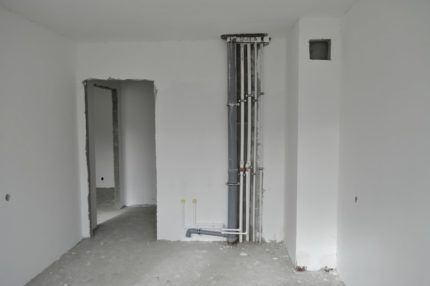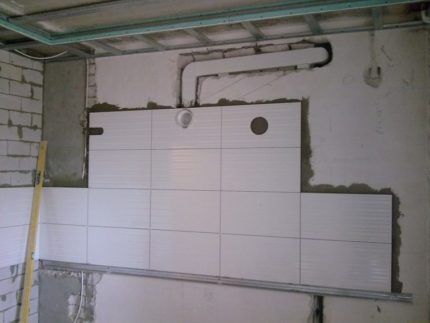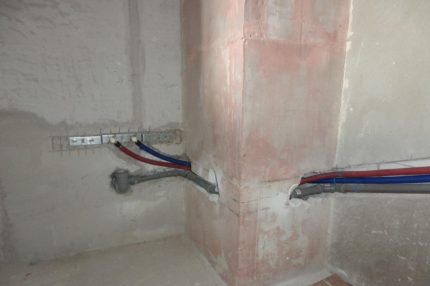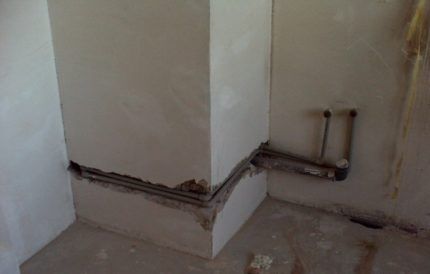Is it possible to trench a ventilation shaft in an apartment: legal nuances of the issue and rules for gating
General building systems and communications were initially planned for placement in each apartment of an apartment building. These are gas and water supply systems, sewerage and ventilation, and the electrical network. However, in many projects of apartment buildings, architects have designed a not entirely convenient location of certain types of communications, including the ventilation shaft, don’t you agree?
In these cases, during a major renovation of an apartment, the owner needs to make changes to the original project or carry out redevelopment. But many changes must be agreed upon with the management company, the chief architect or the district executive authority.
It is about the changes that require approval that we will talk about in this article - we will look in detail at whether it is possible to trench the ventilation shaft during repairs and how to do it correctly. We also focus on the legal nuances of this rather pressing issue.
The content of the article:
How is the ventilation shaft in the apartment?
The ventilation shafts were designed in such a way as to ensure free circulation of air in the room. That is why sometimes they take place in different parts of the apartments, sometimes they are even highlighted with a special box.
A purely technically branched network of ventilation ducts is connected in a ventilation shaft, from which there is already a branch to the attic or roof. However, in new house designs, air is taken at the 2-3 floor level, then cleaned, humidified and sent through ventilation ducts to all floors of the house.An exhaust system operating in parallel is installed on the roof. It extracts heat from the exhaust air and then removes it.
In panel houses, the ventilation shaft is a structure made of concrete blocks installed on top of each other. To implement normal air ventilation, it is necessary that the shaft be perfectly vertical.

The ventilation shaft starts from the ground floor and, passing through all floors, goes to the roof - this is where air flows will be evacuated from the shaft in the future.
As for the parameters, the shaft cross-section and shape depend on the project for which the apartment building was built. The material from which it can be made is concrete, metal or plastic. The structure itself must be made in accordance with sanitary and fire safety standards, as well as using non-combustible materials.
Since the main task of the ventilation shaft is to ensure the circulation of air masses in the premises of the building, it must meet a number of requirements:
- be clean of debris;
- be airtight;
- have free space defined by the project.
Completion of the first item on the list is achieved by timely work on cleaning ventilation ducts, which, as required by the governing documents, must be carried out at least once a year.
The tightness of the shaft is also checked during work. After all, any violation of the integrity of the ventilation shaft leads to a failure in air circulation.Also, the presence of foreign objects in the shaft can cause disruption of air exchange.
The joints between individual ventilation shaft modules must be sealed with concrete mortar. In metal shafts, joints must be made on flanges.

The operation of the mine is regulated SNiP 41-01-2003 and a number of regulatory requirements for the operation of the ventilation system, for operational safety, and according to the standards applied to residential apartment buildings.
Carrying out work with the ventilation shaft
Cutting through walls for various needs using special power tools is called gating. The need for it most often arises when laying wires and pipelines. So, when carrying out renovations in an apartment, specialists initially draw up a layout diagram of the electrical wiring.
The standard number of lighting lamps, sockets and switches are not always convenient to use and often do not meet the requirements of the apartment owner. The comfortable use of electrical appliances depends on the location of these power supply points. Therefore, when designing new electrical points for your convenience, it becomes necessary to prepare channels for laying electrical cables. That's when you'll need gating walls for wiring, including the walls of ventilation shafts.
Gating is also carried out for internal placement of water pipes.These works can also negatively affect the general building ventilation system.
To figure out whether it is possible to carry out work on gating a ventilation shaft in an apartment, you need to look at two main documents:
- Housing Code of the Russian Federation.
- Regulatory documents in construction, in particular regarding ventilation systems.
They describe in detail all the nuances in the design, construction and operation of ventilation shafts.

Summarizing the information from these documents, it can be noted that:
- any change from original design must be agreed upon with the housing authorities (management company, city executive authority), otherwise it will be considered unauthorized redevelopment (article 29 Housing Code of the Russian Federation);
- disruption of the functioning of communications in an apartment building entails administrative liability;
- It is prohibited to use ventilation shafts for personal purposes (even for hanging cabinets), - they can only be used to ensure air exchange;
- It is prohibited to conduct other communications inside ventilation shafts.
In some houses, ventilation shafts are located in the form of a box indoors. They create an irregular shape for the room and reduce its total area. As a rule, such shafts are located between the kitchen and bathrooms. In this situation, the passage of communication systems directly through the ventilation shaft is also impossible.
It is worth noting that some workers still lay communication lines (water and gas pipes, electrical cables) through the shaft, saving on material. The holes are sealed with foam and plastered. However, such a clear violation of the tightness of the ventilation shaft can lead to the fact that all the smell from the lower apartments will leak into the room. In this case, communication wiring is possible between the wall and the ventilation shaft duct in the floor of the room. In any case, communications must be fenced off by a certain building structure.
Consequences of mining a mine
As mentioned above in the article, the use and operation of ventilation shafts is regulated in strict accordance with SNiP 41-01-2003.
And, from the point of view of this document, Gouging ventilation shafts is strictly prohibited. Since any intervention leads to a violation of the tightness and, consequently, disabling the entire building ventilation system.

In accordance with the housing code, a person through whose fault the ventilation system was disabled will incur an administrative penalty and is obliged to restore the damaged section of the ventilation shaft as soon as possible. The fine for trenching a ventilation shaft is 2,500 rubles.
How to make a ditch correctly and legally?
If it becomes necessary to lay pipes or conduct electrical networks in this place, it is necessary to carry out thickening the ventilation shaft wall using gas blocks or other building materials.
After the artificial thickening is created, the necessary communications are laid in it. Such an operation is not considered interference and is absolutely legal.
The main nuance in the legislation is the permission of the following actions with the ventilation shaft:
- expansion of the ventilation shaft opening for grille installation or under a special fan;
- slight hole shift ventilation shaft to the side.
This work must be carried out by a person who has an understanding of how the ventilation shaft works and who is familiar with the ventilation network of this house.

In order to shift the hole, it is necessary to drill and assemble a special satellite channel, which will be a continuation of the ventilation shaft along the wall in the room.
If the satellite channel is installed incorrectly and the ventilation shaft is damaged, unpleasant odors will enter the room from neighboring apartments.
We also recommend that you read transfer rules ventilation hole in the kitchen.
Conclusions and useful video on the topic
The following video describes changes to ventilation ducts and plumbing ducts in the house:
This video shows how you can seal an existing hole in a ventilation shaft and install sockets there. At the same time, the authors of the video also claim that doing this is strictly prohibited:
About the restoration of the ventilation duct after its dismantling in the following video:
Thus, gating a ventilation shaft is considered an illegal operation. Despite the fairly large thickness of the duct in some houses, any impact can cause mechanical damage, which will subsequently lead to improper functioning of the ventilation system. As punishment for damage to public communications, a fine and restoration of the ventilation shaft are provided.
If, after reading the material presented, you have any questions or want to supplement the publication with interesting information based on personal experience, leave your comments, ask questions and participate in the discussion in the special block located below.




Hello! What is the thickness of the Vent channel? And is it possible to make a groove along the edge 15-20 cm long in order to mount a cast iron bathtub? Thank you
In my opinion, my upstairs neighbors violated everything,
all of the above.
Absolutely, completely demolished the ventilation duct and built a dummy from hardboard,
laying pipe and wire inside.
Please tell me what specific rules and regulations
do not allow such reorganization and to which bodies
Besides the locals, can and should you apply?
(the photo shows the ventilation duct of the apartment located on the floor above,
i.e. the view is from below, and the box itself is located in the kitchen and looks like a pillar)
Thank you.
I am interested in 2 questions: 1) the bathroom was a joint project. I want to share it. Thus, the vent shaft remains in the bathroom. Is it possible to connect some kind of ceiling wiring from the toilet to the shaft?
2) is it possible to move the ventilation shaft a little, creating a slight bend in the area of your apartment? The shaft interferes with comfortable placement in the bathroom.
Is it possible to install a ventilation hole with a fan in the main shaft duct?
I live on the 2nd residential floor.